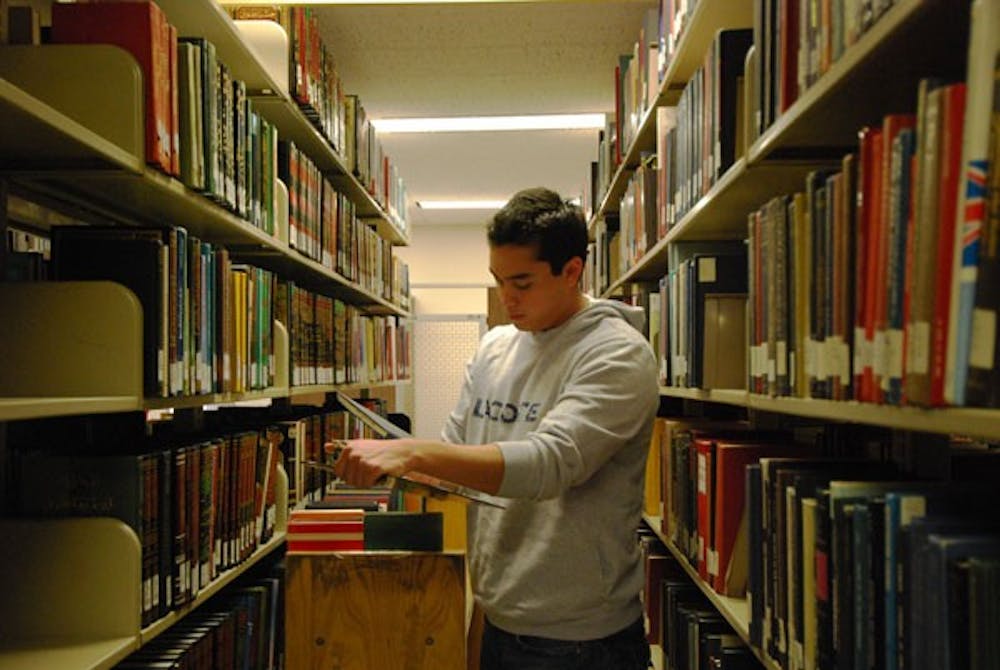 Student worker Jose David Gutierrez, an international student majoring in industrial engineering, pulls books from the special collections section of Hayden Library on Wednesday afternoon. (Photo by Murphy Bannerman)
Student worker Jose David Gutierrez, an international student majoring in industrial engineering, pulls books from the special collections section of Hayden Library on Wednesday afternoon. (Photo by Murphy Bannerman)A room on the fourth floor of the Tempe campus’s Hayden Library holds thousands of rare manuscripts, books, recordings, videos and documents for students to use upon request.
The Luhrs Reading Room hosts almost 25,000 linear feet of material from seven repositories archives at ASU, all packed in numbered blue boxes stacked on seemingly countless rows of shelves.
The University’s library director, Sherrie Schmidt, said the special collections are a great opportunity for students conducting research.
“Usually, students find their way to the reading room because they have a specific need,” she said.
Most of the special collections are gifts to the University and distinguish the libraries at ASU from other research centers, Schmidt said.
“Some students really like to work with unique materials as primary sources for their research,” she said.
The entire catalogue of the special collections is available online and some of the special collections have been digitized.
University Archivist and head of special collections Robert Spindler said students have to know exactly what they are looking for if they wish to work with the materials in person.
“That’s the thing about special collections,” he said. “There’s so much material here that you can’t just go in without knowing.”
The best way to find that information is through the Library Guides at the ASU website, Spindler said.
ASU has been gathering special collections since the 1950s, Spindler said.
“We have so much stuff,” he said. “It’s really hard to identify the highlights.”
ASU is one of 14 institutions that contribute to Arizona Archives Online, a website that digitally catalogues primary source materials.
“We share the responsibility to collect the history of Arizona,” Spindler said.
A description goes online at the AAO as soon as ASU obtains a new collection.
“Once the description is up, the collection is available through an appointment with the curator,” Spindler said.
Although the majority of the material is at Hayden Library, some of the special collections are kept at a high-density storage room at the Polytechnic campus.
A collection represents an obligation to preserve, gather and document the material, Spindler said.
“We think about the needs of ASU when we craft a policy,” he said. “Those needs change over time, but our commitment is permanent.”
Spindler and his team are constantly discovering new material in the collection room.
“We have more than a million photographs,” he said. “We have so much stuff that it’s so exciting when we rediscover something.”
Those in charge of maintaining the special collections are challenged with balancing the digital and paper material.
Spindler said contributors offer ASU a lot of digital material, but they have to be cautious with what they accept.
“While we have wonderful things in paper, it’s the digital material that is becoming overwhelming,” he said.
Many of the collections are donations, so the department spends most of its funds on preservation and digitalization, Spindler said.
“We have to be able to invest in resources and yet provide quality cataloguing, preservation and personal service,” he said.
The Labriola National American Data Center, located on the second floor of Hayden Library, holds material from throughout North America.
Labriola curator Joyce Martin said the center can provide primary sources even for those who are not researching American Indian studies.
“People from a lot of disciplines are interested,” she said. “We get history, architecture and justice studies classes coming to the center.”
The collection space at the Labriola Center is limited, so the center keeps all of its new collections at the Luhrs Reading Room.
The center offers a reference service at the desk to help students find resources online.
“We can help them figure out where to find the materials,” Martin said. “We understand it can sometimes be overwhelming.”
The materials at the center include photographs, oral histories, clippings, manuscripts and books.
The responsibilities of a curator include securing the material, maintaining the collection and making sure it can be found online, Martin said.
The Labriola Center organizes a lecture twice a year with a contemporary indigenous scholar.
“This is an all-around center of learning,” Martin said. “We are not just books and static material.”
Reach the reporter at dpbaltaz@asu.edu or follow her on Twitter @dpalomabp.




